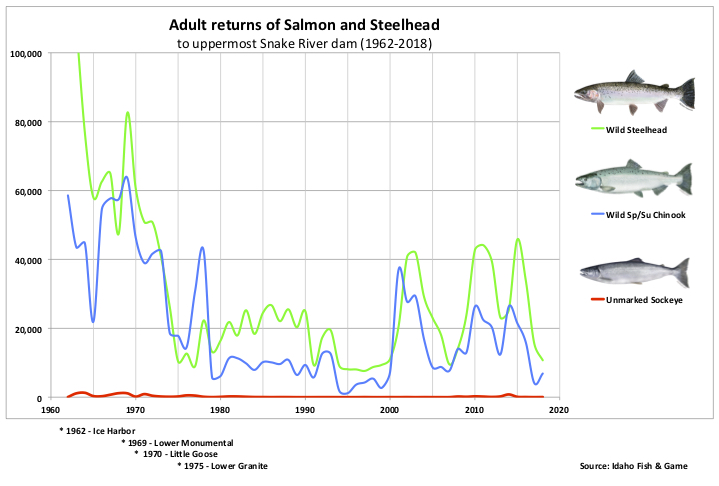forum
library
tutorial
contact

Saving the Salmon in
the Columbia River Basin
by Kurt Miller
The Daily News, October 13, 2020
|
the film forum library tutorial contact |

|
Saving the Salmon in
by Kurt Miller
|
 There has been a lot of news recently about different plans to help recover salmon in light of a recent federal decision to retain the four lower Snake River dams in eastern Washington state.
There has been a lot of news recently about different plans to help recover salmon in light of a recent federal decision to retain the four lower Snake River dams in eastern Washington state.
To have a meaningful discussion, however, it is important that we speak the same language, which is our concern over a recent article, entitled, "Critics vow to continue efforts to remove Snake River dams"
The article includes some unattributed assertions and misstatements that require correction.
For example, the writer states that salmon populations [on the lower Snake River] have "plunged" since the dams were built from the 1960s to 1970s. However, looking at data from University of Washington researchers (cbr.washington.edu/dart/query/adult_annual_sum), the decade-to-decade trend in adult salmon and steelhead returns past Ice Harbor Dam is significantly up since the dam started operating in 1962.
(bluefish notes: PNWA's Miller argues that it is the decade intervals that show the 2010-2019 is higher on average than any other decade. The graphic at right show actual natural-origin yearly returns for you to judge for yourself.)Next, the article states that the vast majority of fish that originate from the Columbia River basin die during the journey to the Pacific Ocean and back, despite billions being spent to save them.
The majority of fish do die during the journey, but that applies to every salmon population for every river because of a litany of natural and human-caused factors. Salmon lay thousands of eggs, with only a small fraction making it back from the sea.
Perhaps the statement of greatest concern in the article is the unattributed remark that "the dams have proven disastrous for salmon." That statement is not consistent with the data. Scientists estimate there were once between 6 to 16 million adult salmon in the Columbia River Basin. Unfortunately, by the late 1800s, commercial overfishing and other human-caused factors reduced salmon populations to near extinction levels. By the time the basin's first federal dam began operating in 1938, adult salmon returns were less than 500,000.
As noted above, adult salmon populations have actually improved since the completion of the four Lower Snake River dams, thanks to successful hatchery programs, despite lower salmon survival rates in the ocean. This is all while these dams have been producing clean, reliable hydropower for the region.
Finally, it's not just salmon from dammed rivers that have seen poorer survival rates. Credible science shows survival rates for Chinook salmon up and down the Pacific Coast have seen an almost uniform decline over the past 50 years. This includes pristine rivers as far north as Alaska.
Scientists believe that the warming, acidifying ocean is causing a shift in balance between salmon predators and prey, along with providing an advantage to Pacific pink salmon. This is one of the reasons our organization has joined a regional effort to advocate for population management of salmon predators, such as pinnipeds and birds. Regional leaders are realizing it will take an "All-H's" approach to our basin's salmon recovery efforts: effective hatchery, harvest, habitat and hydro measures.
In terms of hydro measures, the dams on the lower Snake and Columbia rivers have been upgraded with $2 billion in advanced fish passage technologies since 2000. Juvenile salmon now have an average survival rate past each of those dams of approximately 96%.
As the region comes together to talk about how to recover salmon, it is important that we begin with the same fundamental understandings and that we speak the same language. We hope this context will help.
learn more on topics covered in the film
see the video
read the script
learn the songs
discussion forum
